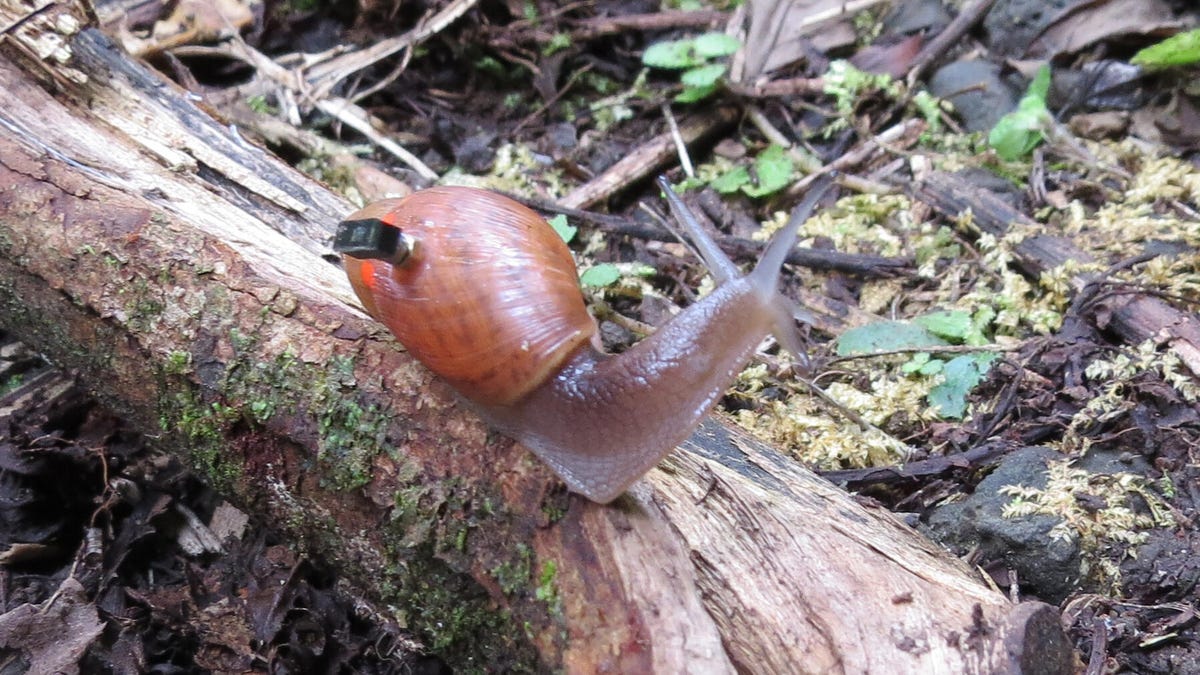Scientists glue tiny computers on snails to solve mass extinction mystery
The world's smallest computer reveals how one species survived a nasty predator.

A tiny computer backpack adorns the shell of this rosy wolf snail.
Using a tiny computer about the size of a pencil eraser, scientists have figured out how a native tree snail species managed to survive a vicious predator that wiped out 50 other snail species in the South Pacific.
French authorities who ran the South Pacific Society Islands introduced that predator, the rosy wolf snail, in 1974 in an attempt to curb the spread of the giant African land snail that had been previously introduced as a food source, according to The Guardian. The rosy wolf snail's actions are less than rosy, despite its moniker. It moves faster than most snails and voraciously attacks and eats snails and slugs.
The Society Islands are a group of islands that support hundreds of endemic animal species, according to the World Wildlife Fund. Of the 61 native tree snail species on the islands before the rosy wolf came to town, Partula hyalina is among just five that survived in the wild.
So how did the white-shelled P. hyalina evade the grips of its predator? In a new study published Tuesday in the journal Communications Biology, University of Michigan scientists reveal their answer.
"We were able to get data that nobody had been able to obtain," said David Blaauw, co-leader of the team that developed the Michigan Micro Mote, or M3, the computer used in the study. "And that's because we had a tiny computing system that was small enough to stick on a snail."
U-M scientists hypothesized in 2015 that P. hyalina was able to persist in sunlit forest edge habitats by donning a shell that reflected rather than absorbed light radiation levels that would kill its darker-shelled counterparts. Their study required them to track the light exposure levels both snail species experienced in a typical day, and that led them to join forces with the UM engineers who created the M3. The inventors call their M3 the "world's smallest computer."
The M3 system had an energy harvester that allowed it to recharge its battery using tiny solar cells. For the study, the snail sleuths measured levels of light by measuring the speed at which the battery charged.
On the island of Tahiti, part of the Society Islands, researchers glued the M3s directly to the rosy wolf snails' shells. P. hyalina is a protected species, so the scientists didn't place the M3s directly on their shells. Instead, they used magnets to place M3s on both the tops and undersides of leaves where they rested. They found that P. hyalina was routinely exposed to significantly higher solar radiation levels in its forest edge habitats than those endured by the predator.
This isn't the last hurrah for the M3. It's also being used by the University of Michigan in a project that aims to track monarch butterflies' migration paths. In the meantime, the Partulas will continue to roam the archipelago thanks to their pale, sun-kissed shells.

